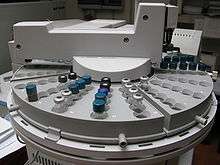Ca' Foscari University of Venice
| Università Ca' Foscari Venezia | |
|
Ca' Foscari and Palazzo Giustinian | |
| Latin: Venetiarum universitas in domo Foscari | |
| Type | State-supported |
|---|---|
| Established | 6 August 1868 |
| Rector | Michele Bugliesi |
| Students | 18,846[1] |
| Location |
Venice, Italy 45°26′04″N 12°19′35″E / 45.4345°N 12.3265°ECoordinates: 45°26′04″N 12°19′35″E / 45.4345°N 12.3265°E |
| Website |
unive |
 | |

.jpg)


Ca' Foscari University of Venice (Italian: Università Ca' Foscari Venezia) is a public university in Venice, Italy; it is usually known simply as Università Ca' Foscari. Since its foundation in 1868 it has been housed in the Venetian Gothic palace of Ca' Foscari, from which it takes its name. The palace stands on the Grand Canal, between the Rialto and San Marco, in the sestiere of Dorsoduro.
The institute became a university in 1968.[2] It currently has eight departments and almost 19,000 students.[1]
History
The institution was founded as the Regia Scuola Superiore di Commercio ("royal high school of commerce") by a Royal Decree dated 6 August 1868, and teaching commenced in December of the same year. The idea of establishing such a school had arisen after the annexation of the Veneto to the new Kingdom of Italy in 1866, and was promoted by three people in particular: the Jewish political economist Luigi Luzzatti, later Prime Minister of Italy; Edoardo Deodati, senator of the Kingdom of Italy and vice-president of the province of Venice; and the Sicilian political economist Francesco Ferrara, director of the school for its first thirty years.[2]
The school was the first institute of higher education in commerce in Italy,[3] and was from the outset conceived as a national rather than a regional institution; it had a diplomatic arm to prepare commercial consular staff for overseas service, and was also a training college for secondary school teachers of commercial subjects. Foreign languages were taught from the start. The school was modelled on the Institut Supérieur de Commerce d'Anvers, founded in 1853 in Antwerp, Belgium.[2]
Following the establishment of a national syllabus for university teaching in 1935, the Istituto Superiore di Economia e Commercio di Venezia, as it was by then called, was authorised to teach and award four-year laurea degrees.[4] In 1968 it obtained university status, and the name was changed to Università degli Studi di Venezia.[2]
Organisation
The university is divided into eight departments:[5]
- Economics
- Philosophy and cultural heritage
- Management
- Environmental science, computer science and statistics
- Molecular science and nanosystems
- Linguistic and comparative cultural studies
- Humanities
- Asian and Mediterranean African studies
Rankings
Università Ca' Foscari last participated in the Institutional Evaluation Programme of the European University Association in 1999.[6] It was not among the fifteen Italian universities in the Times Higher Education World University Rankings top 500 for 2013–14,[7] nor among the nineteen Italian universities in the Academic Ranking of World Universities top 500 for 2013.[8] In the QS World University Rankings for 2013–14 it was ranked 701+, in 21st= (i.e., last-equal) place of the twenty-six Italian universities in the ranking.[9]
In the QS World University Rankings by subject for 2014, Ca' Foscari was ranked 150–200 in both the economics and econometrics and the history and archaeology subject areas.[10]
Ca' Foscari was ranked 105th of the 301 institutions participating in the GreenMetric ranking of universities by environmental impact and sustainability compiled by Universitas Indonesia in 2013, higher than any other participating Italian university.[11]
Notable alumni
- Giuseppe De'Longhi, businessman[12]
- Damiano Michieletto, opera director[13]
See also
References
- 1 2 Regione ateneo: VENETO; Ateneo: "Ca' Foscari" di Venezia; Anno accademico: 2012/2013. Ministero dell'Istruzione, dell'Università e della Ricerca: Anagrafe Nazionale Studenti. Accessed March 2014.
- 1 2 3 4 Giannantonio Paladini (1996). Profilo Storico dell'Ateneo (in Italian). Venice: Università Ca' Foscari; cited at Profilo storico. Archived 18 July 2008.
- ↑ Kaplan, Andreas (2014) European management and European business schools: Insights from the history of business schools, European Management Journal, http://dx.doi.org/10.1016/j.emj.2014.03.006
- ↑ Cesare Maria De Vecchi di Val Cismon, for Vittorio Emanuele III (28 November 1935). Norme relative agli insegnamenti che debbono essere impartiti nelle Università e negli Istituti superiori, Regio decreto 28 novembre 1935–XIV n. 2044 (in Italian). Gazzetta Ufficiale del Regno d'Italia. 284 (6 December 1935): 5565.
- ↑ Università "Ca' Foscari" Venezia (in Italian). Ministero dell'Istruzione, dell'Università e della Ricerca. Accessed March 2014.
- ↑ Institutional Evaluation Programme: Who has participated since 1994?. European University Association. Accessed March 2014.
- ↑ 2013–14. Times Higher Education World University Rankings. Accessed March 2014.
- ↑ Academic Ranking of World Universities 2013. Shanghai Ranking Consultancy. Accessed March 2014.
- ↑ QS World University Rankings 2013: Europe: Italy. QS Quacquarelli Symonds. Accessed March 2014.
- ↑ Università Ca' Foscari Venezia Rankings. QS Quacquarelli Symonds. Accessed March 2014.
- ↑ UI GreenMetric World University Ranking: World Ranking 2013. Universitas Indonesia. Accessed March 2014.
- ↑ "Giuseppe De'Longhi". Forbes. Retrieved 12 May 2015.
- ↑ "Damiano Michieletto". ROH. Retrieved 18 June 2015.
| Wikimedia Commons has media related to Università Ca' Foscari. |